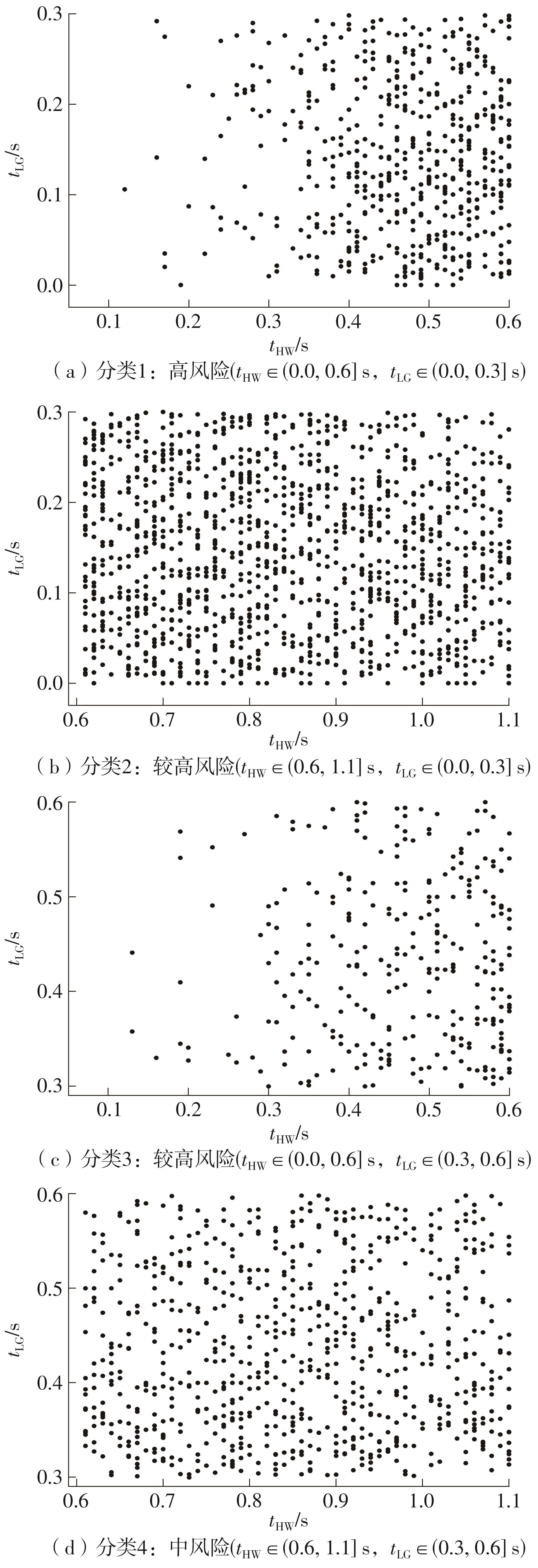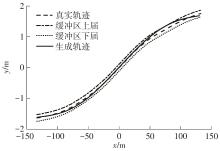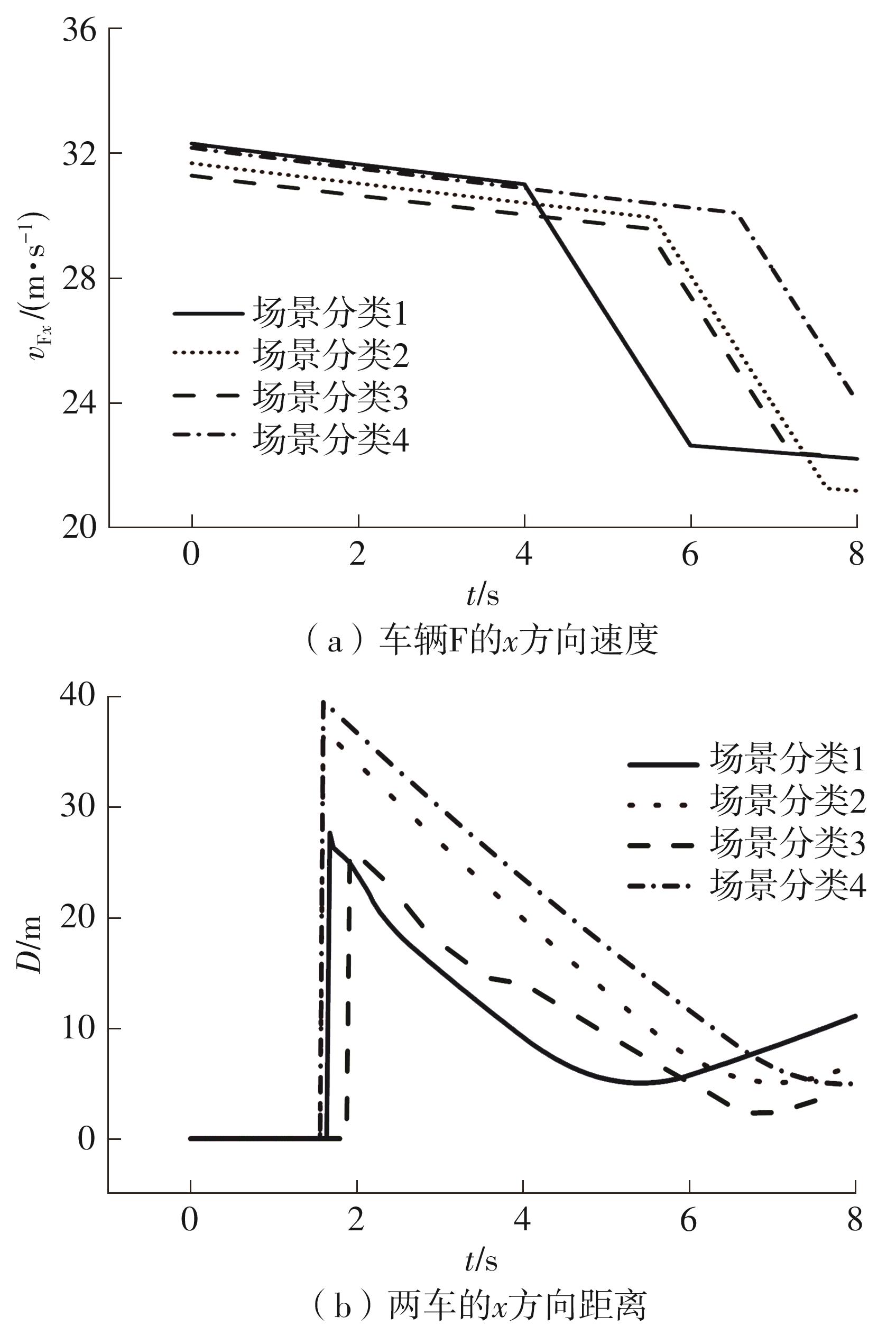Journal of South China University of Technology(Natural Science Edition) ›› 2024, Vol. 52 ›› Issue (8): 76-88.doi: 10.12141/j.issn.1000-565X.230229
Special Issue: 2024年交通运输工程
• Traffic & Transportation Engineering • Previous Articles Next Articles
TsGAN-Based Automatic Generation Algorithm of Lane-Change Cut-in Test Scenarios on Expressways for Autonomous Vehicles
ZHU Yu1 XU Zhigang1 ZHAO Xiangmo1 WANG Runmin1 QU Xiaobo2
- 1.IoV and CAV Testing Technology Research Institute, Chang’an University, Xi’an 710018, Shaanxi, China
2.School of Vehicle and Mobility, Tsinghua University, Beijing 100084, China
-
Received:2023-04-11Online:2024-08-25Published:2024-04-02 -
Contact:徐志刚(1979—),男,博士,教授,博士生导师,主要从事智能交通、车路协同、自动驾驶等研究。 E-mail:xuzhigang@chd.edu.cn -
About author:朱宇(1989—),男,博士生,助理研究员,主要从事自动驾驶汽车测试研究。E-mail: yu.zhu@chd.edu.cn -
Supported by:the Shaanxi Science Fund for Distinguished Young Scientists(2023-JC-JQ-45);the National Key Research and Development Program of China(2021YFB2501200);the Key Project of the National Natural Science Foundation of China(52232015);the Key Research and Development Program of Shaanxi Province(2021LLRH-04-01-03)
CLC Number:
Cite this article
ZHU Yu, XU Zhigang, ZHAO Xiangmo, et al. TsGAN-Based Automatic Generation Algorithm of Lane-Change Cut-in Test Scenarios on Expressways for Autonomous Vehicles[J]. Journal of South China University of Technology(Natural Science Edition), 2024, 52(8): 76-88.
share this article
| 1 | 王雪松,杨敏明 .基于自然驾驶数据的变道切入行为分析[J].同济大学学报(自然科学版),2018,46(8):1057-1063. |
| WANG Xuesong, YANG Minming .Cut-in behavior analyses based on naturalistic driving data[J].Journal of Tongji University (Natural Science),2018,46(8):1057-1063. | |
| 2 | 王雪松,李艳 .基于自然驾驶数据的驾驶员变道特征分析[J].交通信息与安全,2016,34(1):17-22. |
| WANG Xuesong, LI Yan .Characteristics analysis of lane changing behavior based on the naturalistic driving data[J].Journal of Transport Information and Safety,2016,34(1):17-22. | |
| 3 | 郭柏苍,雒国凤,金立生,等 .面向自动驾驶虚拟测试的变道切入场景库构建方法[J].吉林大学学报(工学版),2023,53(11):3130-3140. |
| GUO Bo-cang, LUO Guo-feng .JIN Li-sheng,et al.Construction method of cut-in scenario library for automatic driving virtual tests[J].Journal of Jilin University (Engineering and Technology Edition),2023,53(11):3130-3140. | |
| 4 | XU D, DING Z, ZHAO H,et al .Naturalistic lane change analysis for human-like trajectory generation[C]∥Proceedings of 2018 IEEE Intelligent Vehicles Symposium.New York:IEEE,2018:1393-1399. |
| 5 | HUANG W, LV Y, CHEN L,et al .Accelerate the autonomous vehicles reliability testing in parallel paradigm[C]∥Proceedings of IEEE 20th International Conference on Intelligent Transportation Systems.Piscataway:IEEE,2017:922-927. |
| 6 | XU Z, JIANG Z, WANG G,et al .When the automated driving system fails:dynamics of public responses to automated vehicles[J].Transportation Research Part C:Emerging Technologies,2021,129(4):103271/1-13. |
| 7 | XU Z, WANG G, ZHAI S,et al .When automation fails:examining the effect of a verbal recovery strategy on user experience in automated driving[J].International Journal of Human-Computer Interaction,2023.Doi:10.1080/10447318.2023.2176986. |
| 8 | GAO Y, ZHAO X, XU Z,et al .An indoor vehicle-in-the-loop simulation platform testing method for autonomous emergency braking[J].Journal of Advanced Transportation,2021,2021:8872889/1-12. |
| 9 | GELDER E, PAARDEKOOPER J .Assessment of automated driving systems using real-life scenarios[C]∥Proceedings of 2017 IEEE Intelligent Vehicles Symposium.Piscataway:IEEE,2017:589-594. |
| 10 | JENKINS I R,GEE L, KNAUSS A,et al .Accident scenario generation with recurrent neural networks[C]∥Proceedings of IEEE 21st International Confe-rence on Intelligent Transportation Systems.Pisca-taway:IEEE,2018:3340-3345. |
| 11 | ZHAO D, LAM H, PENG H,et al .Accelerated evaluation of automated vehicles safety in lane-change scenarios based on importance sampling techniques[J].IEEE Transactions on Intelligent Transportation Systems,2017,18(3):595-607. |
| 12 | ZHAO D, HUANG X, PENG H,et al .Accelerated evaluation of automated vehicles in car-following maneuvers[J].IEEE Transactions on Intelligent Transportation Systems,2018,19(3):733-744. |
| 13 | ZHAO H, WANG C, LIN Y,et al .On-road vehicle trajectory collection and scene-based lane change analysis:Part I[J].IEEE Transactions on Intelligent Trans-portation Systems,2017,18(1):192-205. |
| 14 | GUO Y, KALIDINDI V V, ARIEF M,et al .Modeling multi-vehicle interaction scenarios using Gaussian random field[C]∥Proceedings of IEEE 22th International Conference on Intelligent Transportation Systems.Piscataway:IEEE,2019:3974-3980. |
| 15 | XU Z, WANG Y, WANG G,et al .Trajectory optimization for a connected automated traffic stream: comparison between an exact model and fast heuristics[J].IEEE Transactions on Intelligent Transportation Systems,2021,22(5):2969-2978. |
| 16 | GAO Y, LI J, XU Z,et al .A novel image-based convolutional neural network approach for traffic congestion estimation[J].Expert Systems with Applications,2021,180:115037/1-13. |
| 17 | LI J, XU Z, FU L,et al .Domain adaptation from daytime to nighttime:a situation-sensitive vehicle detection and traffic flow parameter estimation framework[J].Transportation Research Part C:Emerging Technologies,2021,124:102946/1-19. |
| 18 | KRAJEWSKI R, BOCK J, KLOEKER L,et al .The highD dataset:a drone dataset of naturalistic vehicle trajectories on German highways for validation of highly automated driving systems[C]∥Proceedings of IEEE 21st International Conference on Intelligent Transportation Systems.Piscataway:IEEE,2018:2118-2125. |
| 19 | KRAJEWSKI R, MOERS T, BOCK J,et al .The rounD dataset:a drone dataset of road user trajectories at roundabouts in Germany[C]∥Proceedings of IEEE 23rd International Conference on Intelligent Transportation Systems.Piscataway:IEEE,2020:1-6. |
| 20 | BOCK J, KRAJEWSKI R, MOERS T,et al .The inD dataset: a drone dataset of naturalistic road user trajectories at German intersections[C]∥Proceedings of 2020 IEEE Intelligent Vehicles Symposium.Pisca-taway:IEEE,2020:1929-1934. |
| 21 | MOERS T, VATER L, KRAJEWSKI R,et al .The exiD dataset:a real-world trajectory dataset of highly interactive highway scenarios in Germany[C]∥Proceedings of 2022 IEEE Intelligent Vehicles Symposium.Piscataway:IEEE,2022:958-964. |
| 22 | FENG S, FENG Y, YU C,et al .Testing scenario library generation for connected and automated vehicles,Part I:methodology[J].IEEE Transactions on Intelligent Transportation Systems,2021,22(3):1573-1582. |
| 23 | FENG S, FENG Y, SUN H,et al .Testing scenario library generation for connected and automated vehicles,Part II:case studies[J].IEEE Transactions on Inte-lligent Transportation Systems,2021,22(9):5635-5647. |
| 24 | HUANG Z, LAM H, ZHAO D .An accelerated testing approach for automated vehicles with background traffic described by joint distributions[C]∥Proceedings of IEEE 20th International Conference on Intelligent Transportation Systems.Piscataway:IEEE,2017:933-938. |
| 25 | ROCKLAGE E, KRAFT H, KARATAS A,et al .Automated scenario generation for regression testing of autonomous vehicles[C]∥Proceedings of IEEE 20th International Conference on Intelligent Transportation Systems.Piscataway:IEEE,2017:476-483. |
| 26 | YAO W, ZHAO H, DAVOINE F,et al .Learning lane change trajectories from on-road driving data[C]∥Proceedings of 2012 IEEE Intelligent Vehicles Symposium.Piscataway:IEEE,2012:885-890. |
| 27 | XU G, LIU L,OU Y,et al .Dynamic modeling of driver control strategy of lane-change behavior and trajectory planning for collision prediction[J].IEEE Transactions on Intelligent Transportation Systems,2012,13(3):1138-1155. |
| 28 | WANG Z, ZHAO X, XU Z,et al .Modeling and field experiments on autonomous vehicle lane changing with surrounding human-driven vehicles[J].Computer-Aided Civil and Infrastructure Engineering,2021,36(7):877-889. |
| 29 | KRAJEWSKI R, MOERS T, NERGER D,et al .Data-driven maneuver modeling using generative adversarial networks and variational autoencoders for safety validation of highly automated vehicles[C]∥Proceedings of IEEE 21st International Conference on Intelligent Transportation Systems.Piscataway:IEEE,2018:2383-2390. |
| 30 | SCHILDBACH G, BORRELLI F .Scenario model predictive control for lane change assistance on highways[C]∥Proceedings of 2015 IEEE Intelligent Vehicles Symposium.Piscataway:IEEE,2015:611-616. |
| 31 | SHIWAKOTI S, BIKRAM SHAHI S, SINGH P .Deep learning methods for vehicle trajectory predic-tion:a survey[C]∥JOBY P P,ALENCAR M S,FALKOWSKI-GILSKI P.IoT Based Control Networks and Intelligent Systems (Proceedings of 4th ICICNIS 2023).Singapore:Springer,2023:539-554. |
| 32 | 朱宇,赵祥模,徐志刚,等 .基于蒙特卡洛模拟的无人车高速公路变道虚拟测试场景自动生成算法[J].中国公路学报,2022,35(3):89-100. |
| ZHU Yu, ZHAO Xiang-mo, XU Zhi-gang,et al .Automatic generation algorithm of lane-change virtual test scenario on highways for automated vehicles using Monte Carlo simulation[J].China Journal of Highway and Transport,2022,35(3):89-100. | |
| 33 | YOON J, JARRETT D, SCHAAR M V D .Time-series generative adversarial networks[C]∥Proceedings of the 33rd International Conference on Neural Information Processing Systems.Red Hook:Curran Associa-tes Inc,2019:5508-5518. |
| 34 | 胡远志,吕章洁,刘西 .基于PreScan的AEB系统纵向避撞算法及仿真验证[J].汽车安全与节能学报,2017,8(2):136-142. |
| HU Yuan-zhi, LV Zhang-jie, LIU Xi .Algorithm and simulation verification of longitudinal collision avoi-dance for autonomous emergency break (AEB) system based on PreScan[J].Journal of Automotive Safety and Energy,2017,8(2):136-142. | |
| 35 | ZHANG Y, ANTONSSON E, GROTE K .A new threat assessment measure for collision avoidance systems[C]∥Proceedings of IEEE 9th International Conference on Intelligent Transportation Systems.Pisca-taway:IEEE,2006:968-975. |
| 36 | HUANG Z, ZHAO D, LAM H,et al .Evaluation of automated vehicles in the frontal cut-in scenario—an enhanced approach using piecewise mixture models[C]∥Proceedings of 2017 IEEE International Conference on Robotics and Automation.New York:IEEE,2017:197-202. |
| 37 | 朱冰,张培兴,赵健 .面向多维度逻辑场景的自动驾驶安全性聚类评价方法[J].汽车工程,2020,42(11):1458-1463,1505. |
| ZHU Bing, ZHANG Peixing, ZHAO Jian .Clustering evaluation method of autonomous driving safety for multi-dimensional logical scenario[J].Automotive Engineering,2020,42(11):1458-1463,1505. | |
| 38 | 朱西产,张佳瑞,马志雄 .安全切入场景下的驾驶人初始制动时刻分析[J].中国公路学报,2019,32(6):262-273,318. |
| ZHU Xi-chan, ZHANG Jia-rui, MA Zhi-xiong,et al .Analysis of driver initial brake time in safety cut-in scenario[J].China Journal of Highway and Transport,2019,32(6):262-273,318. | |
| 39 | 朱西产,魏昊舟,马志雄 .基于自然驾驶数据的跟车场景潜在风险评估[J].中国公路学报,2020,33(4):169-181. |
| ZHU Xi-chan, WEI Hao-zhou, MA Zhi-xiong .Assessment of the potential risk in car-following scenario based on naturalistic driving data[J].China Journal of Highway and Transport,2020,33(4):169-181. | |
| 40 | MULDER M, ABBINK D A, VAN PAASSEN M M,et al .Design of a haptic gas pedal for active car-following support[J].IEEE Transactions on Intelligent Transportation Systems,2011,12(1):268-279. |
| 41 | 马依宁,姜为,吴靖宇,等 .基于不同风格行驶模型的自动驾驶仿真测试自演绎场景研究[J].中国公路学报,2023,36(2):216-228. |
| MA Yi-ning, JIANG Wei, WU Jing-yu,et al .Self-evolution scenarios for simulation tests of autonomous vehicles based on different models of driving styles[J].China Journal of Highway and Transport,2023,36(2):216-228. | |
| 42 | 卢胜,王正刚,李纯厚 .频谱相似性目标识别算法[J].声学技术,2010,29(1):94-98. |
| LU Sheng, WANG Zheng-gang, LI Chun-hou .An algorithm for object discrimination by spectra similarity[J].Technical Acoustics,2010,29(1):94-98. | |
| 43 | 王结臣,卢敏,苑振宇,等 .基于Ripley’s K函数的南京市ATM网点空间分布模式研究[J].地理科学,2016,36(12):1843-1849. |
| WANG Jiechen, LU Min, YUAN Zhenyu,et al .Point pattern analysis of ATMs distribution based on Ripley’s K-function method in Nanjing City[J].Scientia Geographica Sinica,2016,36(12):1843-1849. | |
| 44 | 葛莹,刘尉,李勇 .Ripley’s K函数方法修正与估计方法比较[J].武汉大学学报(信息科学版),2023,48(6):970-978. |
| GE Ying, LIU Wei, LI Yong .Algorithm modification and estimation comparison of Ripley’s K-function[J].Geomatics and Information Science of Wuhan University,2023,48(6):970-978. |
| [1] |
ZHONG Shaopeng, LIU Ao, ZHAI Junnuo, et al.
A Review of The Multi-Level Urban Impacts of Shared Autonomous Vehicles [J]. Journal of South China University of Technology(Natural Science Edition), 2025, 53(6): 104-118. |
| [2] | CAO Ningbo, ZHAO Liying. Management Method of Autonomous Vehicles and Pedestrians at Intersections Based on Maximum Pressure Controls [J]. Journal of South China University of Technology(Natural Science Edition), 2024, 52(2): 124-135. |
| [3] | ZHANG Ting, CHEN Feng, LI Huang, et al. Evaluation of the Effect of Self-Luminous Road Marking in Expressway Weaving Section Based on Driving Behavior [J]. Journal of South China University of Technology(Natural Science Edition), 2024, 52(11): 106-117. |
| [4] | JIANG Shengchuan, ZHONG Shan, WU Difei, et al. Virtual Generation Method of Transportation Infrastructure Crack Images [J]. Journal of South China University of Technology(Natural Science Edition), 2024, 52(10): 146-158. |
| [5] | QIANG Ruiru, ZHAO Xiaoqiang. A Small Sample Rolling Bearing Fault Diagnosis Method Based on Gramian Angular Difference Field and Generative Adversarial Network [J]. Journal of South China University of Technology(Natural Science Edition), 2024, 52(10): 64-75. |
| [6] | WANG Linhong, LI Hongtao, LI Ruonan. Design of Speed Limit at Expressway in Rainy Day Considering Drivers’ Visual Search Ability [J]. Journal of South China University of Technology(Natural Science Edition), 2023, 51(6): 20-29. |
| [7] | MA Shuhong, YANG Lei, CHEN Xifang. Resilience Evolution of Multi-mode Transportation Network in Urban Agglomeration Based on Risk Diffusion [J]. Journal of South China University of Technology(Natural Science Edition), 2023, 51(6): 42-51. |
| [8] | ZHU Zhengyu, LUO Chao, HE Qianhua, et al. Multi-View Lip Motion and Voice Consistency Judgment Based on Lip Reconstruction and Three-Dimensional Coupled CNN [J]. Journal of South China University of Technology(Natural Science Edition), 2023, 51(5): 70-77. |
| [9] | HU Yucong, WEI Hu, ZENG Qiang . Analysis of Freeway Crash Severity Based on Spatial Generalized Ordered Probit Model [J]. Journal of South China University of Technology(Natural Science Edition), 2023, 51(1): 114-122. |
| [10] | LU Kai, ZHAO Shijie, WU Huan, et al. Algebraic Method of Coordination Design for Bi-directional Red and Green Waves of Saturated Intersection [J]. Journal of South China University of Technology(Natural Science Edition), 2022, 50(9): 1-11. |
| [11] | LU Kai, WU Wei, DENG Xingdong, et al. Composition and Optimization Method of Coordination Path Set in Control Subarea [J]. Journal of South China University of Technology(Natural Science Edition), 2022, 50(2): 1-14. |
| [12] | MA Xinlu, FAN Bo, CHEN Shiao, et al. Evaluation and Analysis Model for Freeways Crash Risk Based on Real-Time Traffic Flow [J]. Journal of South China University of Technology(Natural Science Edition), 2021, 49(8): 19-25,34. |
| [13] | CHEN Jiqing, SHU Xiaoxiong, LAN Fengchong, et al. Construction of Autonomous Vehicles Test Scenarios with Typical Dangerous Accident Characteristics [J]. Journal of South China University of Technology (Natural Science Edition), 2021, 49(5): 1-8. |
| [14] | CHANG Xin, LI Haijian, RONG Jian, et al. Effect of the Tunnel Warning System on Traffic Capacity Based on Aggregated Spatiotemporal Characteristics of Vehicles [J]. Journal of South China University of Technology (Natural Science Edition), 2020, 48(9): 107-115,123. |
| [15] | WEN Huiying ZHANG Weigang ZHAO Sheng. Vehicle Lane-Change Trajectory Prediction Model Based on Generative Adversarial Networks [J]. Journal of South China University of Technology (Natural Science Edition), 2020, 48(5): 32-40. |
| Viewed | ||||||
|
Full text |
|
|||||
|
Abstract |
|
|||||

















